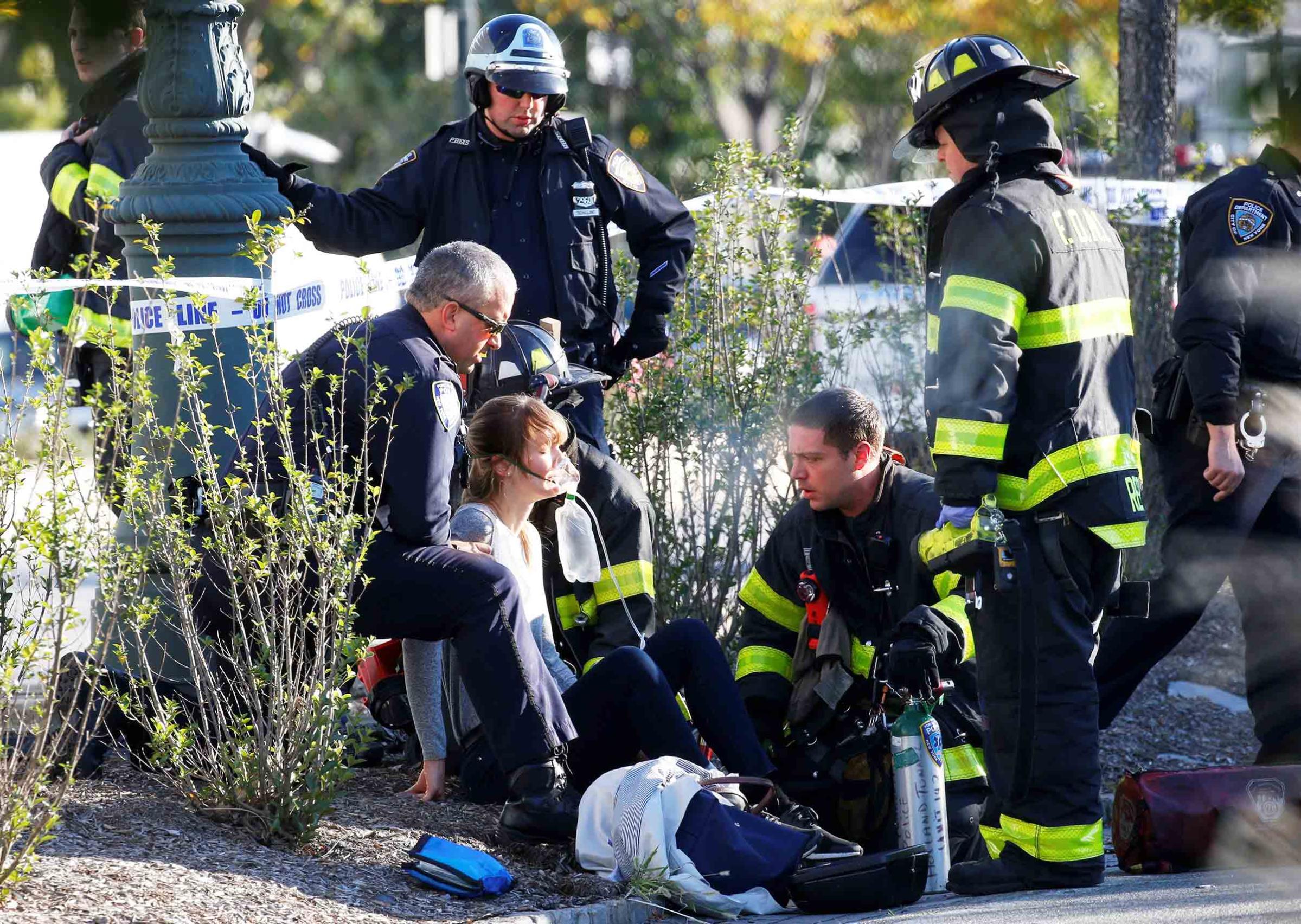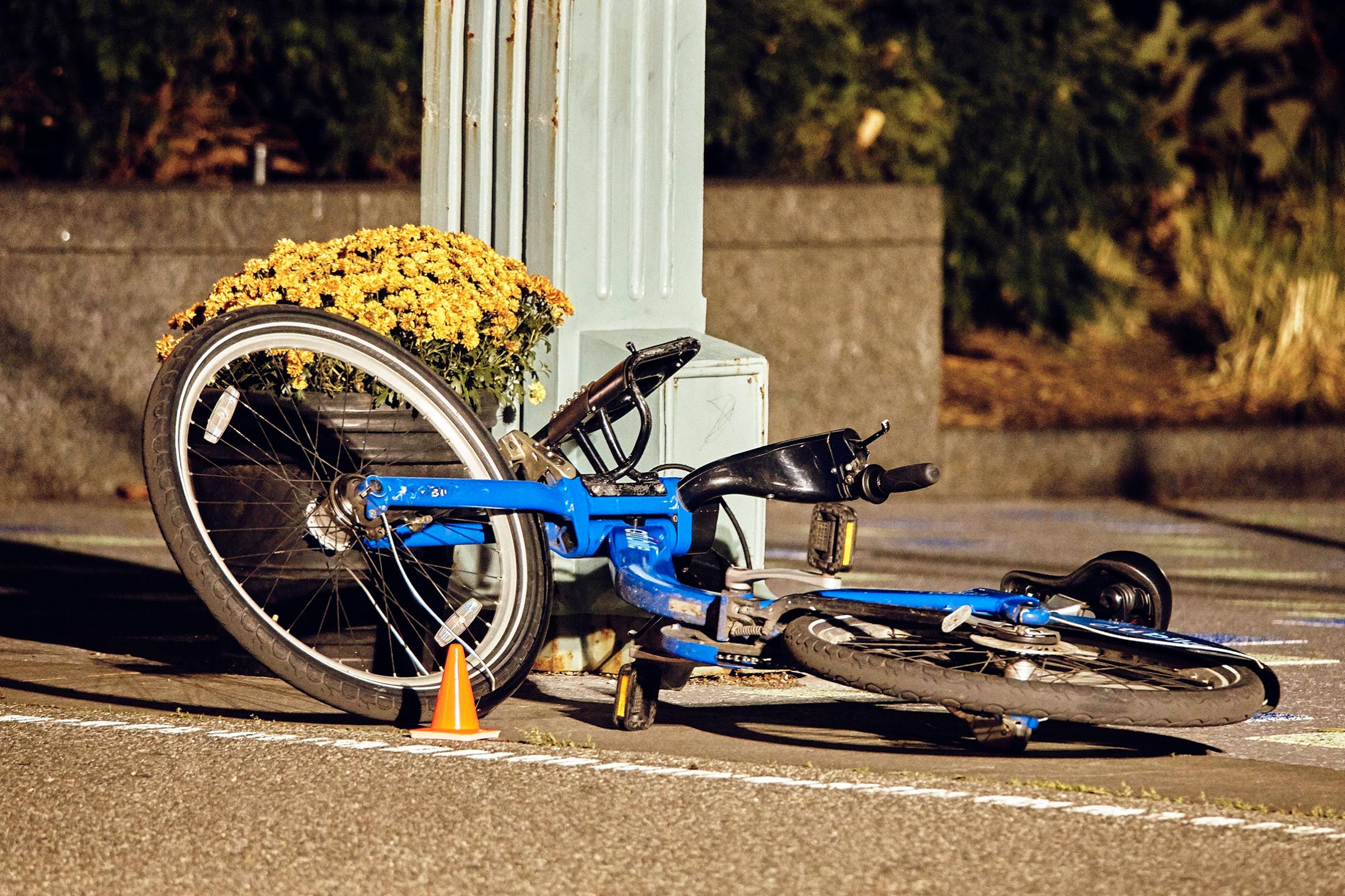In the 16 years after the Twin Towers fell, the desolation of lower Manhattan in time gave way to a blossoming. When Sayfullo Saipov drove his rented Home Depot truck onto a bicycle path at 3:04 p.m. on Oct. 31, killing eight people beneath its wheels, he careened down the Hudson River Greenway, a lushly landscaped urban esplanade. At Houston Street, where he first steered onto the path, a pier now does service as a soccer field. His route south took him past trees, benches and charmingly inventive playgrounds with miniature golf and beach volleyball before he crashed into a school bus at Chambers Street under the glass and steel high-rises of the financial district.
That six of the eight fatalities were tourists came as no shock to New Yorkers, who in the city’s landmark neighborhoods navigate streams of visitors, many astride the Citi Bikes that lay crushed on the asphalt pathway. Foreign visits to the city dropped after 2001, but they have more than doubled since, to nearly 13 million a year. At the 9/11 Memorial, four to five blocks beyond where a police officer shot and wounded Saipov, there are days that a passerby, hurrying under the adolescent swamp white oaks that ring the black granite pools and the 2,983 names inscribed atop its walls, hears not a word of English spoken.
Terrorism has also changed since 9/11. Al-Qaeda, with its singular passion for spectacular destruction and its hierarchical command structure, never pulled off an encore. But its narrative of a Western war against Islam gained traction after the U.S. invasion of Iraq, spawning ISIS, a militant Islamic guerrilla group that doubled as a movement open to all. Near the rented truck, officials found a handwritten note lauding ISIS. New York Governor Andrew Cuomo said Saipov had grown interested in ISIS only after entering the U.S. from his native Uzbekistan in 2010.
ISIS encourages self-starters, and officials said they knew of no evidence that this was anything other than the form terrorism has taken of late in the West: the lone-wolf vehicular attack that has claimed dozens of lives in Nice, Berlin, London, Stockholm and Barcelona. “The insight is anyone can pull this off, even when there are defensive countermeasures put in place,” says Clint Watts, a former FBI counterterrorism special agent.
The New York City police department has been preoccupied with terrorism since the first attempt to bring down the World Trade Center, in 1993 (with a bomb loaded into a truck rented, like Saipov’s vehicle, in New Jersey). Today more than 1,000 members of the NYPD are devoted to counterterrorism. Only some of that rank are meant to be seen, like the helmeted officers bearing assault rifles in the hours after the attack in the Oculus, the transit hub and shopping mall that–with its soaring atrium and white wingspan–many regard as a symbol of rebirth beside Ground Zero.
But in a city where 37% of residents were born overseas, the NYPD also relies on an ambitious intelligence network, regarded as second only to the CIA’s. A decade after 9/11, that effort came under fire for overreaching and was called out for its surveillance of mosques and whole neighborhoods. But it remains a robust effort, woven into the fabric of a city defined by its waves of new arrivals. In a cab not long ago, the driver rolled down the window to chat in Bengali with a traffic officer. When we moved on, the driver said he had been asking after the cop’s son, who was also NYPD, but “doesn’t wear a uniform; he’s just around.”

The Halloween attack was the first fatal terrorist strike in New York City since Sept. 11, 2001. Its toll was also emotional.
“I got out of the subway and heard the sirens and thought, Oh God. Oh God. Not this again,” says Michaela Jones, 28, who was a teenager living in Queens on 9/11. Now, not an hour after Saipov was brought down, Jones held the hand of her 2-year-old daughter, dressed as Cinderella; she had just picked her up at day care a stone’s throw from the 9/11 Memorial.
“It’s a part of life for everyone in New York,” says Walter Wickiser, an art dealer who lived two blocks away when the towers fell. “It can happen to anyone.”
The aftermath to the bike-path attack carried a different quality, however. With victims along 20 blocks, it was not immediately clear what had happened. A mother waiting in her car to pick up her kids on Chambers Street heard the rental truck crumple the school bus–“It was like aluminum foil,” she said–but an hour later still thought she had witnessed a hit-and-run.
Halloween, meanwhile, went forward. Behind yellow police tape, a teenager dressed as a mummy, swaddled in toilet paper and masking tape, held Wonder Woman’s hand. In Greenwich Village, the city’s annual costume parade proceeded, with extra police joining the throngs.
Nor was this terrorist attack an occasion for solemn declarations of political unity. At NYPD headquarters, Mayor Bill de Blasio stood beside Cuomo, his longtime rival, both calling for stoic resilience. But President Trump quickly took up a cudgel, tweeting early the next morning that the suspect had entered on “the ‘Diversity Visa Lottery Program,’ a Chuck Schumer beauty.”
Saipov did indeed enter the U.S. on that program, which allots visas at random to citizens of nations who account for few U.S. immigrants. But Schumer, a New Yorker and the Senate’s ranking Democrat, was not only an architect of the visa plan signed by President George H.W. Bush in 1990; he also moved to roll it back in 2013. That effort passed the Senate but died in the GOP-controlled House. “I guess it’s not too soon to politicize a tragedy,” Schumer tweeted in response.
In naked political terms, the attack offered something for nearly everyone. Advocates of stricter gun laws could point to what Saipov held, as he circled the pavement after the collision, shouting, “Allahu akbar”: in one hand, a pellet gun, and in the other, a paintball gun. None of the shots he fired were fatal, and it’s possible that New York City’s firearm laws, which are among the strictest in the nation, helped hold down the death toll.

Advocates of tougher immigration restrictions summoned fresh outrage. Uzbekistan, an overwhelmingly Muslim nation in Central Asia, was not on the list of countries whose residents were to be barred from U.S. entry by Trump’s latest travel ban (which a federal court in Hawaii has suspended). But six hours after the attack, the President underscored a newer program in effect at airports worldwide: “I have just ordered Homeland Security to step up our already Extreme Vetting Program. Being politically correct is fine, but not for this!” he tweeted.
Those who argue for more nuanced antiterrorism measures also pressed their case. “I have always believed and continue to believe that immigration is good for America,” Schumer said in a statement. “President Trump, instead of politicizing and dividing America, which he always seems to do at times of national tragedy, should be focusing on the real solution–antiterrorism funding–which he proposed cutting in his most recent budget.”
The emerging facts around Saipov also had a familiar ring. In interviews with neighbors and associates, the suspect was described in terms similar to the Chechen mastermind of the Boston Marathon bombing: less than successful and given to anger, especially on the question of U.S. military actions in Muslim nations. At 29, he had lived in Florida, Ohio and, recently, New Jersey; he was married and had young children.
News reports said Saipov was already known to U.S. investigators, apparently because he had associated with people suspected of preparing to act on extremist views. Officials said he had planned the attack for more than a year and timed it to Halloween in hopes of injuring more people. The FBI on Nov. 1 announced that it was seeking a second man, Mukhammadzoir Kadirov, also from Uzbekistan, in connection with the attack.
After the Charlie Hebdo attack, when former ISIS fighters rampaged across the offices of a Paris satirical weekly with assault weapons, the NYPD counterterrorism unit drilled on how to contain and neutralize a rifle attack in the city. When the threat became trucks, they paid calls on truck- and car-rental agencies across the region, including New Jersey, briefing clerks on what might constitute a suspicious customer. Saipov, who had worked as a truck driver, evidently was not flagged.
“People are essentially copying what works,” says Charlie Winter, a researcher with the International Centre for the Study of Radicalisation and Political Violence in London. “It’s very clearly something that doesn’t take much planning and can have a high impact. I think it’s that rather than some kind of organizational ingenuity on ISIS’s part.”
Two blocks beyond Chambers Street, the crowds that gather for the 9/11 Memorial are protected by stainless-steel bollards, a security effort that functions as part of the public display. There will certainly be some soon where Houston Street meets the bike path, security being, like terrorism, a feature of the New York City landscape.
–With reporting by SIMON SHUSTER/BERLIN; JARED MALSIN/CAIRO; HALEY SWEETLAND EDWARDS/NEW YORK; and TESSA BERENSON and PHILIP ELLIOTT/WASHINGTON
More Must-Reads from TIME
- Donald Trump Is TIME's 2024 Person of the Year
- Why We Chose Trump as Person of the Year
- Is Intermittent Fasting Good or Bad for You?
- The 100 Must-Read Books of 2024
- The 20 Best Christmas TV Episodes
- Column: If Optimism Feels Ridiculous Now, Try Hope
- The Future of Climate Action Is Trade Policy
- Merle Bombardieri Is Helping People Make the Baby Decision
Contact us at letters@time.com